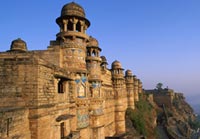
A historical city in the state of Madhya Pradesh, Gwalior is known for its stunning monuments, grand palaces and serene temples. The city takes you down the memory lanes where you learn about some unheard tales about India’s past. Emerald hills add to the beauty of the majestic charm of the city and make your trip to Gwalior a memorable one.
Gwalior Fort
This remains one of the top places to visit in Gwalior. This massive fort sits on a hill top and can be accessed by entering the Qila Gate (Gwalior Gate). The fort together holds numerous palaces, temples and water tanks. The Man mandir, the Gujari, the Jahangir, the Karan, and the Shah Jahan are beautiful looking palaces of the fort which make many jaws drop with their stunning architecture. Also, explore the Siddhachal Jain Temple Caves here constructed from 7th to 15th century. Some of the main temples of the Gwalior Fort include Urvahi, Gopachal, Teli ka mandir and Sahastrabahu (Sas-Bahu) temple. The fort also houses Gujari Mahal which is now a museum displaying Hindu and Jain sculptures belonging to the 1st and 2nd centuries BC.
Jai Vilas Palace
Built in the 19th century, Jai Vilas Palace has now been transformed into a museum. The museum sprawls over an area of 12,40,771 square feet and houses a huge Durbar Hall showcasing world's heaviest chandeliers apart from stunning gold furnishings, and a lavish carpet. The palace flaunts European architecture along with Tuscan and Corinthian styles.
Man Mandir Palace
Man Mandir Palace was built by the Tomar ruler, Man Singh Tomar between 1486 and 1516. The palace is an unmatched architectural wonder of that era. The palace features two open courts apart from an underground prison cells where Aurangzeb kept his brother, Murad. There is also a nearby Jauhar Kund where various Rajput women committed suicide to save themselves from being raped by the forces of Iltutmish.

Gwalior Zoo
For the lovers of wildlife, nothing can be more gratifying than the Gwalior Zoo where one can spot numerous exotic species of animals. People flock here to see white tigers apart from black bucks, serpents, hyena, sambhar, bisons and deer.
Sun Temple
The Surya Mandir or Sun Temple remains the most stunning shrine of the city which is also an architectural wonder. Dedicated to the holy Sun God, the temple was built in 1988 by the famous industrialist G.D. Birla. The red sandstone exterior of the temple can be spotted from far and its surrounding with emerald gardens which look stunning. The temple premises bestow seamless calmness where one can meditate for hours.
Memorial of Tansen
Tansen Memorial was built in the memory of Tansen, a legendary musician of the bygone era. Tansen adorned the court of Akbar with his remarkable music. The Memorial showcases Mughal style of architecture with lush green surroundings. ?Numerous National level music festivals are organised at this memorial every year.??
By Air: Gwalior Airport receives regular flights from other major cities of the country.
By Train: The city has two railway junctions namely Gwalior Junction (GWL) and Birlanagar (BLNR) which are well connected to other major Indian cities.
By Road: One can easily get bus service to the city from all parts of India.